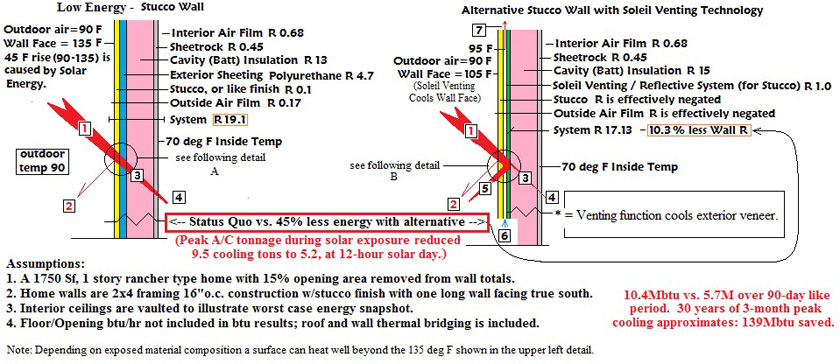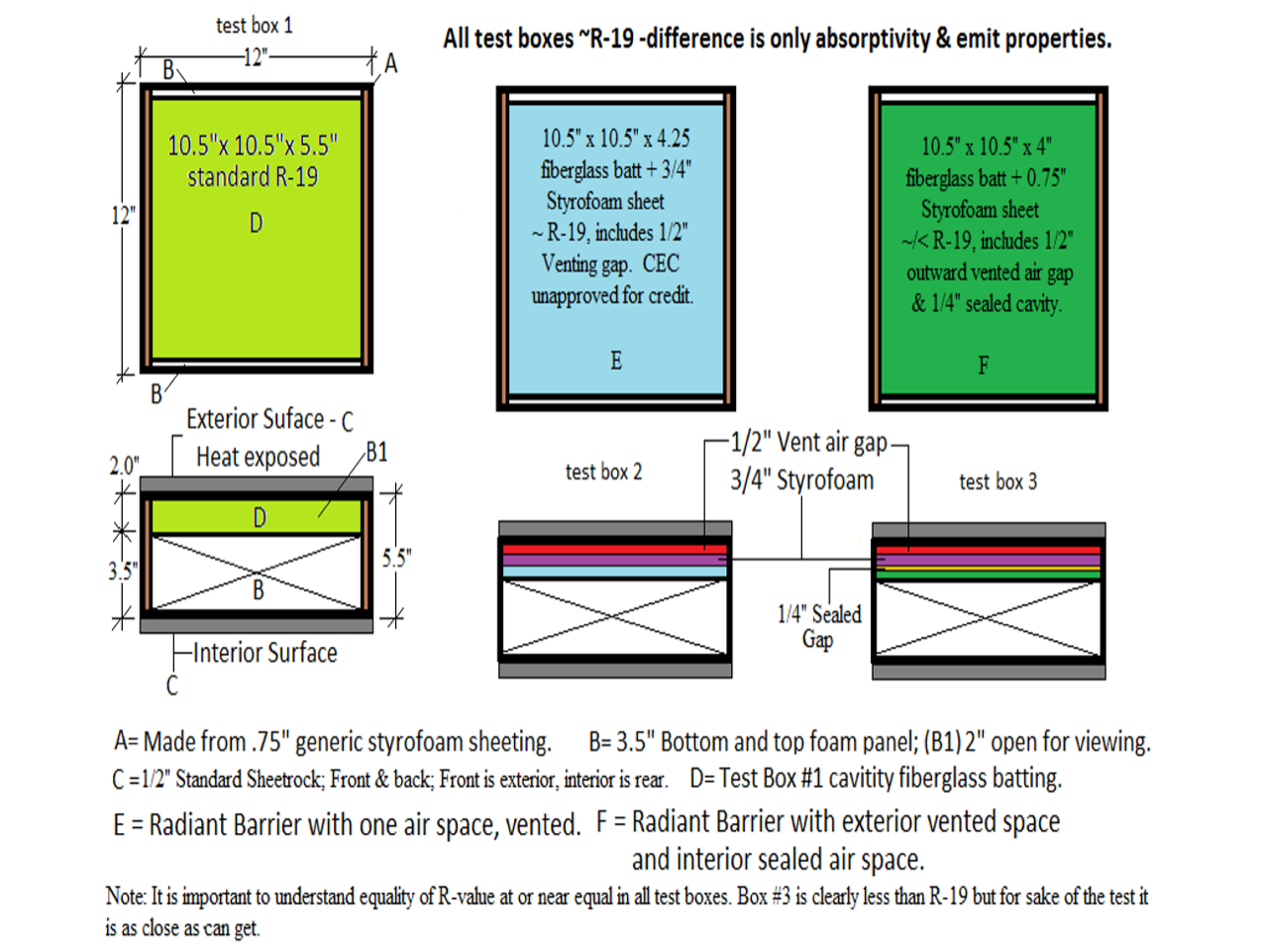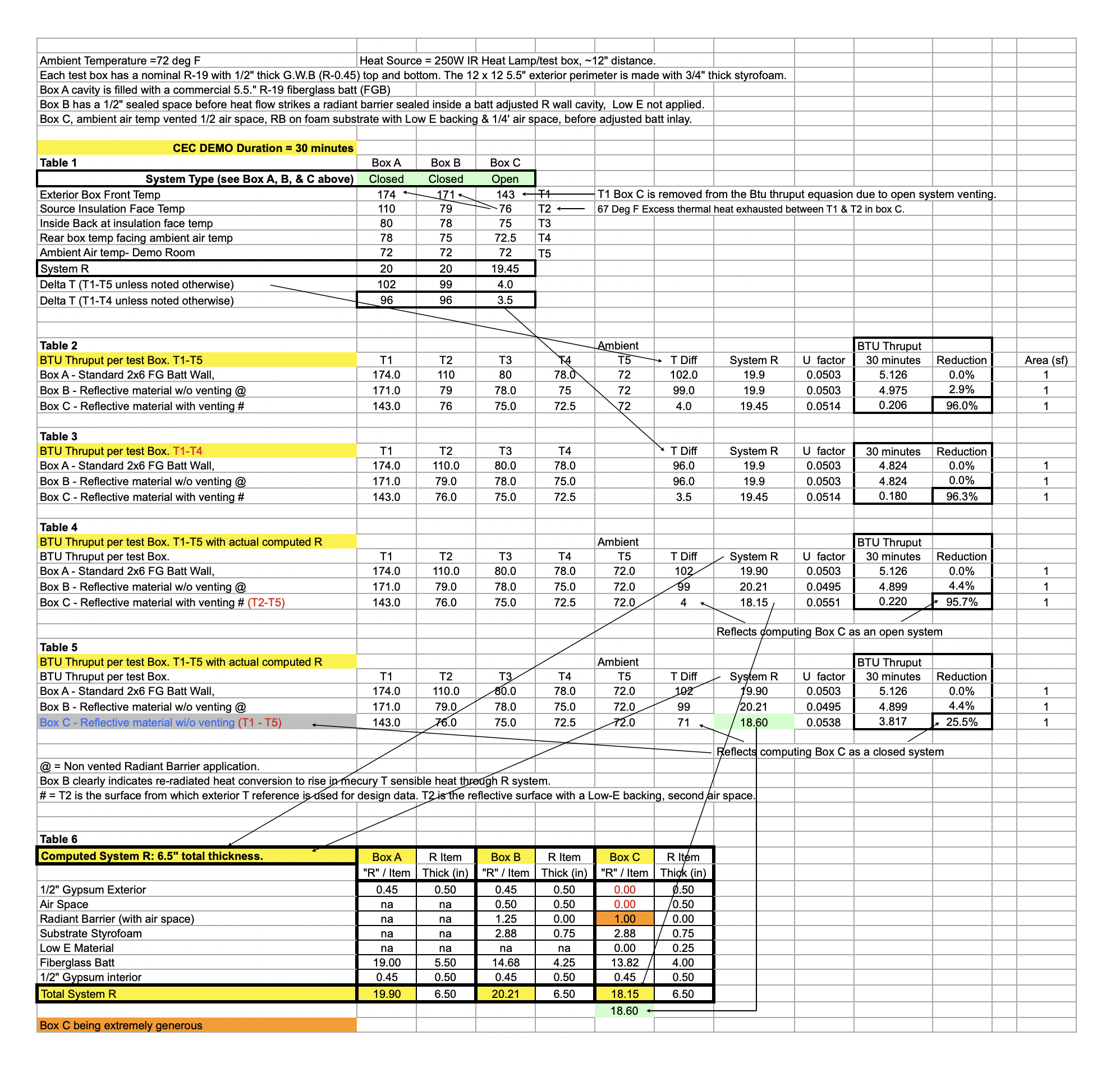The Technology
The new high-tech panels sandwich a core, covered on both sides with a radiant barrier, with an air space between it and the outside skin. Without an air space adjacent to the radiant barrier, it cannot function as a mirror reflecting heat, just as a hand mirror requires adjacent air space to reflect light.

Two radiant barriers act as heat mirrors operating independently, based on the direction of heat flow, to either reflect radiant heat energy or retard its emission.
How it Works
In summer, when solar radiant heat encounters the solid exterior building surface, heat transfer continues inward as conductive heat until it reradiates into the outer exterior air space, where it is reflected and vented back in the atmosphere, preventing much heat gain. In winter, when internal building heat reradiates into the inner air space, it is reflected back into the structure, preventing heat loss. After the first air space reflects radiant heat, the second air space further retards heat emission either into or out of the structure. Additionally, in summer a film prevents contamination of the radiant barrier while venting in summer, and in winter, when vents close, it prevents moisture damage to all building materials, including the significant lowering of fiberglass insulation resistance.
In short, this is a dynamic artificial environment beneath the exterior building veneer; an efficient, much needed disruption of today’s continuous conduction through walls and roofs.
Resistance to Solar Radiant Heat
The below stucco walls, tested with the same thickness and heat source, demonstrated with 10% less R-Value, 45% less energy than conventional insulation was required to maintain an interior temperature at 70° F.

|
|
Without reflectivity and venting, the outdoor |
With opaque vented and radiation-resistant |
Adding these new insulation boards into many conventional insulation systems would reduce BTU/hr. throughput a minimum of 50%; some systems could experience upward of 90% BTU/hr. reductions.
Numerous improvements illustrated in the above comparison:
- Left: Nearly all the heat from the exterior stucco, superheated 45° F above the ambient air temperature, is conducted through the adjacent polyurethane insulating sheeting into the wall structure. Right: The stucco’s heat radiates into an air chamber where the heat is mostly reflected and exhausted.
- Right: After radiant heat is reflected and exhausted, conductive heat energy absorption is again inhibited by the Low-E (Emission) core and re-radiates into the rear air space.
- The exterior surface temperature of the new insulation technology wall is 30°F lower than the control wall.
- Conventional insulation sheeting adjacent to the stucco – even if wrapped with a radiant barrier, as some are for additional fire protection – cannot reflect radiation because a radiant barrier cannot reflect radiation without an adjacent air space.
- When ventilating, the exterior air space draws in outside filtered air as it exhausts heat. At night cool air can pre-cool exterior walls to create net cooling at no cost.
- A fan could expedite ventilation.
- The exhausted heat, at no cost, may be used in a heat exchanger or as heat for another system (e.g., domestic hot water or heat pump).
This opaque insulation can be:
- Cost-efficiently mass-produced in 3/4-inch boards or rolls with standard materials and equipment;
- Manufactured (a) with desired finished surfaces (b) attached to conventional insulation or (c) added as a stand-alone board or wrap;
- Rolled on like wallpaper, to be applied against the inside surfaces of climate-exposed walls and roofs to retrofit existing buildings;
- Manufactured with owner-selected finishes;
- Installed rapidly and easily by unskilled labor;
- Sold to a huge new market for existing buildings, which currently cannot be cost-efficiently retrofitted.
CEC and CBSC demonstration
The presentation of this demonstration is described under Building Code Inclusion on our About Us page.

Three test boxes, all approximately R-19, were simultaneously and identically heated above room temperature for 30 minutes by radiant heat lamps: control box A was typically 2x6 framed R-19 cavity fill insulated wall. Test boxes B and C had 5/8” reflective and ¼” low emission air spaces adjacent to typical CA Title 24 radiant barriers on either side of a core. The only difference was that the air in the reflective space and in Box C was vented but not in Box B.
Box B reduced the heat flow by 3% compared to Box A. However, Box C, by naturally venting from its reflective air space, reduced the heat flow by 96% compared to box A.
Dimensions of each test box: 12 x 12 x 5.5” interior depth, 6.5” outside to outside when including R-0.45 gypsum wallboard covers. Each box had an R-19 insulation rating. However, boxes B & C had (less) thickness of fiberglass batting to compensate for substrate and air spaces, Box perimeters are composed of ¾” Styrofoam. Each box was heated using 250W IR heat lamps.
Shown as Top/Bottom cross-center cut view: Exterior is heat lamp side, interior opposing side

- Ordinary ½” gypsum (R-0.45) wall board (GWB) as exterior & interior wall veneer surfaces
- ¾” ordinary standard Styrofoam box frame perimeter
- Dead/Trapped air between 1 & 5, closed system
- Standard R-19, 5.5” fiberglass batt
- 97% Infrared heat-reflective mirror material
- Substrate for heat mirror material (¾” standard lightweight Styrofoam)
- Adjusted fiberglass thickness for contributions of 3 & 6 to equal R-19
- ½ inch vertically vented duct space; heated air between 1 & 5 free to evacuate space. Heat evacuated from system is heat not available to conduct through system R
- 98% Low E material
- ¼ inch vertical space for Low E material to function
- Due to venting function System R is #5 through to GWB back Fiberglass batt thickness was adjusted thinner for inclusion of 6 & 10 to equal R-19 + R-0.45 GWB = R19.45
- 2” gap between Boxes while under test. System R is R-19.9 for Box A & B
- Box A is R-19.9: R-18 fiberglass and two R-0.45 sheetrock; Box B is also R-19.9 with the R-value of the Styrofoam support offsetting the air space; Box C is R-19.45 because of the additional air space
- Heat Lamp distance for Infrared spread to limit heat emitted onto GWB surface of each box
Refined product

Calculations for CEC and CBSC demonstration

Leonard Studies
The savings in energy costs with the new insulation technology could more than halve most current retrofitting amortization periods by allowing existing buildings to achieve 50% to more than 80% reductions in energy consumption for cooling and heating. For applications in older buildings click on Masonry Buildings or Curtain Wall Buildings. Venting channel reflective systems could be made so light they could be effectively applied under roofs, decks, shingles, etc., without replacing existing insulation or straining the structure.
Several cities, states and nations, including California have pledged to meet the “2030 Challenge” for “Zero Net Energy” (ZNE), the goal for buildings to produce as much energy as they consume. ZNE can be achieved with a prodigious production of solar energy. However, one study determined that with new opaque insulation technology, 31,000 of 70,000 solar panels designed to achieve ZNE could have been eliminated or used to generate surplus at the University of California at Davis’ new West Village complex.


